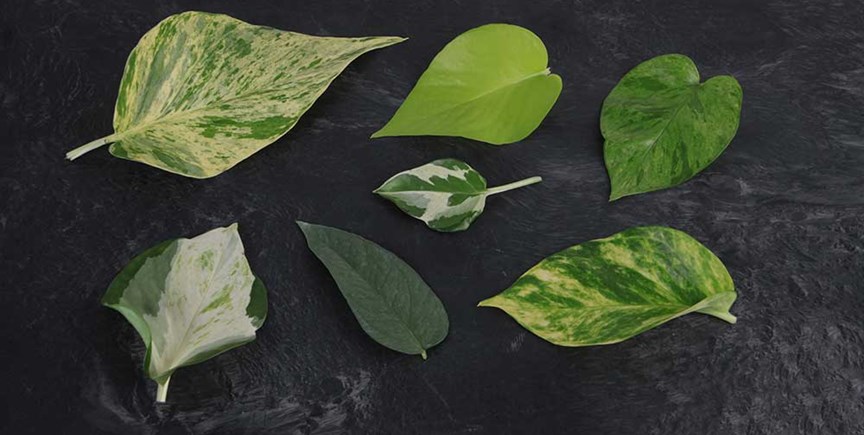With the scientific name Epipremnum aureum, Pothos is a popular houseplant known for its versatility and low maintenance.
It’s also referred to by other names in different countries, such as Scindapsus aureus and Rhaphidophora aurea, though it’s important to note that these are distinct species.
This article will explore the various Epipremnum kinds or types of Pothos plants, offering insights into their unique features and care requirements.
Many households are familiar with Pothos, often choosing them as a starter plant due to their hardy nature.
These tropical vine plants feature long stems and heart-shaped leaves, making them an ideal choice for home decoration.
Their ability to thrive in various conditions makes them a perfect example of the diverse kinds available.
Ways in Which You Can Grow Pothos
- You can grow and hang Pothos in pots on your porch or in the garden.
- These plants can also be trained to grow to a totem or moss pole, showcasing their climbing ability.
- They are versatile enough to be grown horizontally on tabletops, windowsills, and mantles, proving their adaptability in different settings.
What Suits Pothos the Best?
Pothos plants can adjust in low light, but brighter light in an indoor environment is advisable for optimal growth. They do not require frequent watering; moist soil is sufficient for their potting needs.
The large variety of Pothos available makes them a favorite among garden enthusiasts, allowing for the creation of a personalized green space with lots of variegation.
There are many Pothos varieties, each with unique characteristics that set them apart. This article aims to cover as many Epipremnum kinds as possible, helping you find the perfect fit for your home or garden.
Types of Pothos Plants
1. Golden Pothos (Botanical name – Epipremnum aurem)
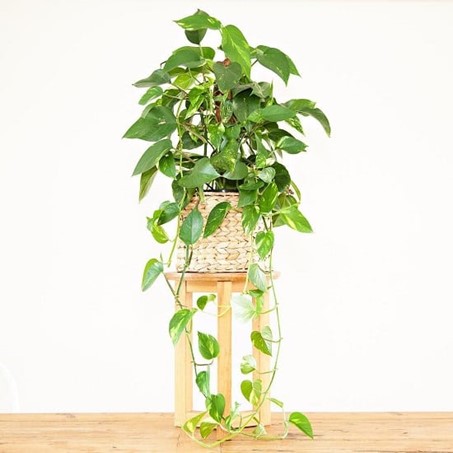
Golden Pothos, a traditional choice in the family of Pothos, is known for its heart-shaped mid-green foliage with creamy golden or yellow splashes.
This variety is particularly suited for low-light environments, such as bedrooms, making it versatile.
The leaves can grow significantly large when provided with adequate sunlight and warmth, especially in frost-free areas.
2. Neon Pothos (Botanical name – Epipremnum ‘Neon’)
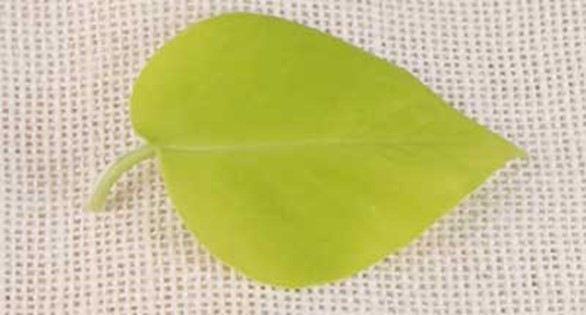
Neon Pothos stands out in the Epipremnum family with its bright green, almost translucent leaves. This variety, lacking variegation, offers a monochromatic aesthetic.
The intensity of the leaf color varies with age and light exposure, making it a dynamic addition.
3. Cebu Blue Pothos (Botanical name – Epipremnum pinnatum ‘Cebu Blue’)
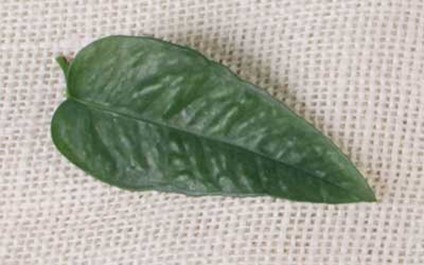
Cebu Blue Pothos is distinguished by its bluish-green, arrow-shaped leaves, adding a unique color palette.
This variety matures slowly, evolving from vague young leaves to large, blue-green adult leaves with natural splits.
4. Marble Queen Pothos (Botanical name – Epipremnum aurem ‘Marble Queen’)
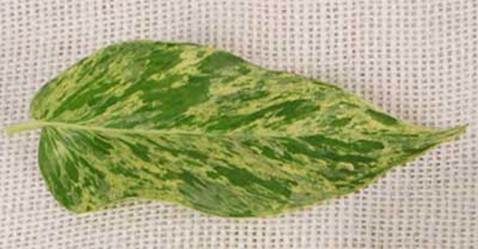
The Marble Queen variety grows heart-shaped leaves with creamy-white stripes, similar to Golden Pothos but with its unique variegation pattern.
This plant’s growth rate may be slower due to the presence of chlorophyll, which also adds to its sculptural value.
5. Jessenia Pothos (Botanical name – Epipremnum’Jessenia’)
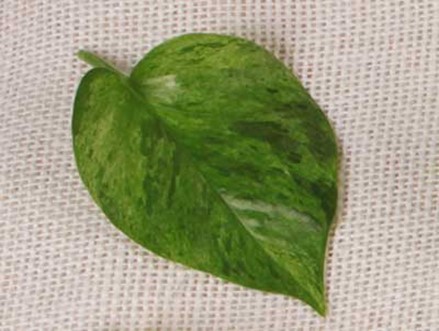
Jessenia Pothos’s leaves are tinged with dark and pea green, offering a lush appearance.
Its variegation pattern resembles Marble Queen but has distinctive limey-green and dark green shades. This variety’s popularity makes it a sought-after member.
6. Manjula Pothos (Botanical name – Epipremnum aurem ‘Manjula’)
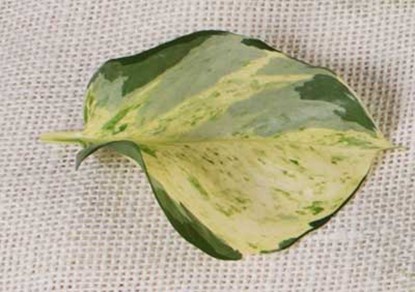
Manjula Pothos, known as the Epipremnum ‘happy leaf,’ showcases wide, heart-shaped leaves with a mix of silver, cream, light green, and white shades.
Each leaf of this patented variety by the University of Florida has a unique pattern, contributing to the diversity of these plants.
7. Pearls and Jade Pothos (Botanical name – Epipremnum ‘Pearls and Jade’)
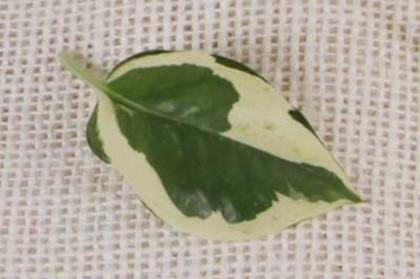
Pearls and Jade Pothos is an attractive and elegant houseplant. This variety features dark green leaves variegated with silverish-gray and white. The variegation is more noticeable from the middle to the edges of the leaves.
Unlike other varieties, the white sections of the foliage are often marked with green and silvery gray tones. Pearls and Jades typically have smaller leaves and grow at a slow pace. They require consistent moisture to thrive.
Pearls and Jade Pothos adds an oriental touch to any space. It is best displayed prominently to showcase its artistic leaf patterns.
8. Silver or Satin Pothos (Botanical name – Epipremnum ‘Satin’)
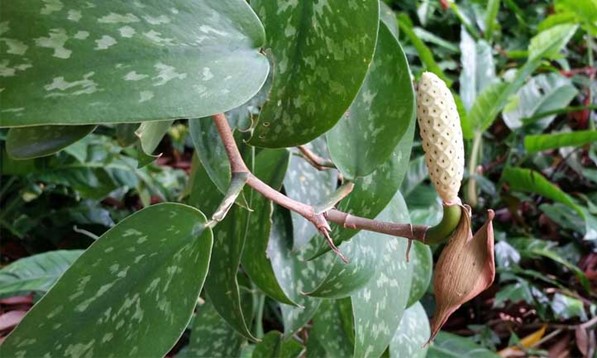
Silver or Satin Pothos, correctly classified under the Scindapsus genus, offers dark green foliage with heart-shaped leaves.
These leaves are distinguished by their patches of silver. The leaves are generally smaller than other Pothos varieties.
The vine-like growth and shimmering leaves make this plant attractive to interior spaces. For optimal growth, keep the plant in bright, indirect light.
9. N – Joy Pothos
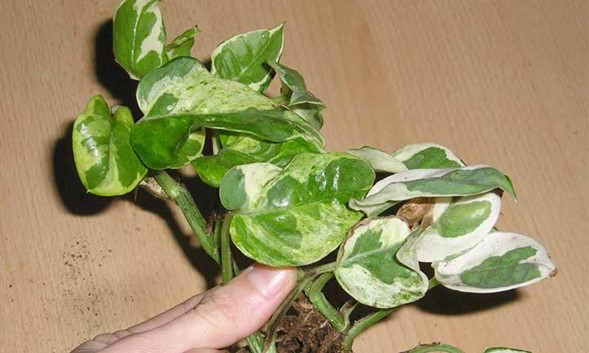
N-Joy Pothos, a relatively new addition to the Pothos family, features heart-shaped green leaves speckled with white.
The intensity of the variegation can increase with exposure to bright, indirect light.
10. Devil’s Ivy Pothos
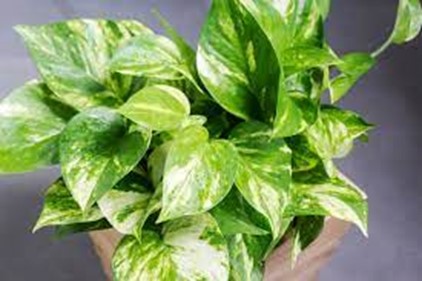
Devil’s Ivy, also known as Golden Pothos or Epipremnum aureum, is popular due to its low maintenance. It has dense foliage with a slight variation in the dark green shade of the leaves.
This plant can grow up to 3 ft long indoors and is ideal for creating a vertical accent, such as growing up a moss pole.
Devil’s Ivy thrives in low to medium light, making it suitable for rooms with less natural light, such as bathrooms.
11. Glacier Pothos
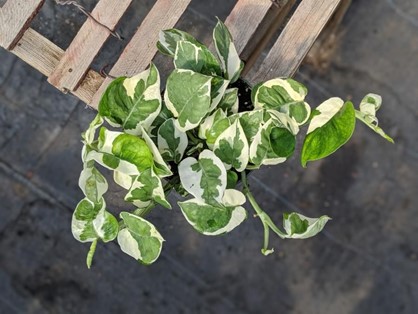
Hawaiian Pothos is known for its long leaves, making it a unique member of the Pothos family.
It is often used in gardens but can be kept indoors with regular pruning to control its growth.
12. Hawaiian Pothos
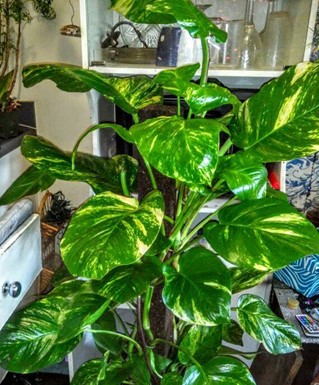
Hawaiian Pothos is a little different from other Pothos. They cultivate long leaves compared to others. Thus, most people include them in a garden rather than keeping them inside the home.
An attractive vertical accent is created because of the long vine-like leaves. If you still want to place them in your home, do the required trimming regularly. It will stay short with controlled stem growth.
13. Trebi Pothos
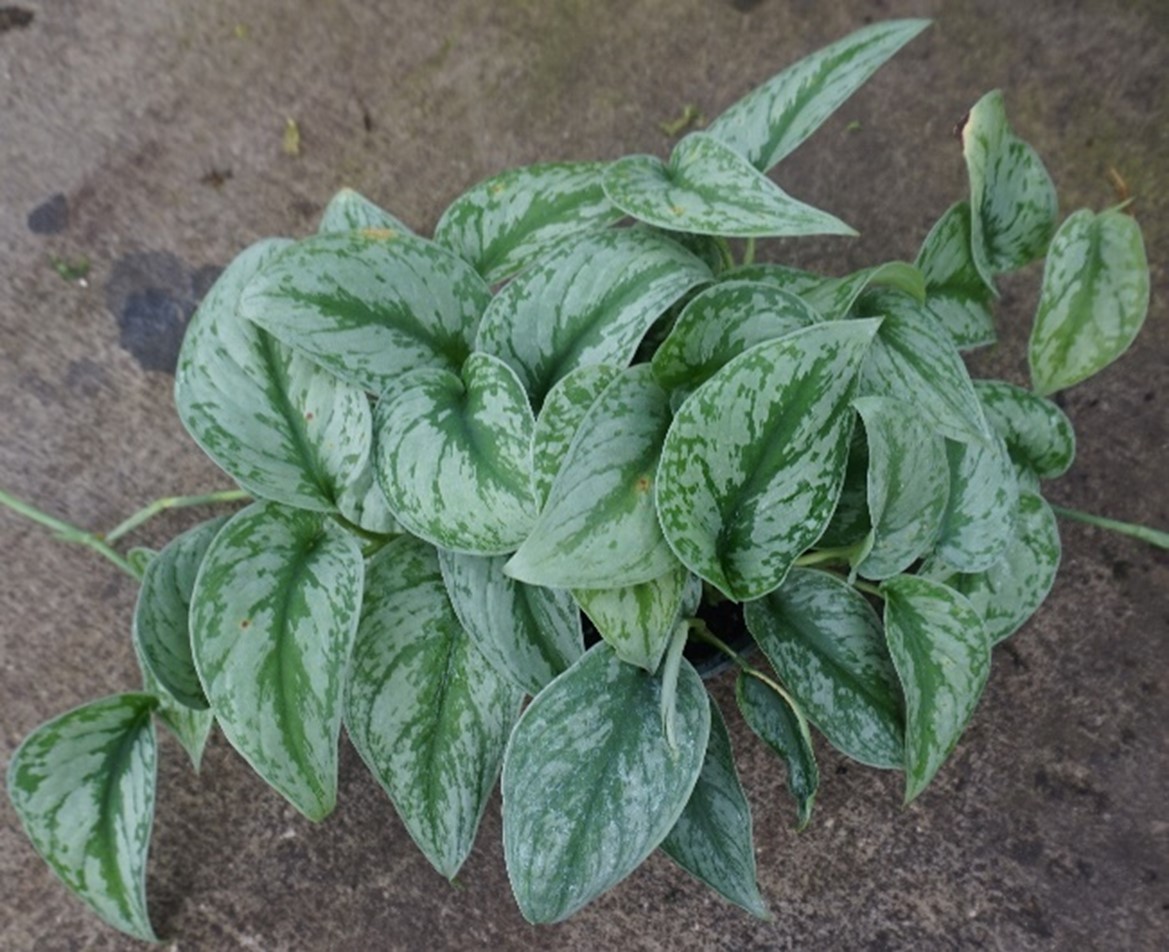
Trebi Pothos, part of the Scindapsus genus, is often confused with Satin Pothos but is a distinct variety. It has elongated leaves with a silver-blue marbling effect. Although it’s not as vibrant as other varieties, its unique appearance adds to its appeal.
Other cultivars of Scindapsus include:
- Scindapsus pictus ‘Argyraeus,’ with light silvery variegation on deep green leaves.
- Scindapsus pictus ‘Exotica,’ similar to ‘Trebi,’ with silver splashes on green leaves.
- Scindapsus pictus ‘Silver Ann’ features more silver than green on its leaves.
What is Common in All the Pothos?
Pothos plants are recognized for their air-purifying qualities, as they are included in NASA’s list of clean-air houseplants.
Characteristically, they feature heart-shaped leaves and exhibit dual coloration, with the primary color being green (ranging from light to dark shades) and secondary colors including white, cream, or silver.
Pothos are low maintenance and adaptable to low-light conditions, making them suitable for indoor spaces like bedrooms, halls, and bathrooms.
However, they require careful watering as over or under-watering can negatively affect their health.
How to Distinguish Pothos from One Another?
Pothos, such as Golden Pothos, Pearls and Jade Pothos, and Marble Queen Pothos, among others, can be differentiated primarily by their leaf variegation.
Each variety exhibits unique patterns and colors on its leaves.
For instance, while some Pothos may have predominantly dark green leaves, others might display lime-colored leaves or variegation with white, cream, or silver hues.
Observing these leaf color and pattern variations is key to identifying different Pothos types.
What are the Light Requirements of Pothos?
Pothos plants are adaptable to various lighting conditions. They can grow in low light but thrive and display more vibrant colors when placed in bright, indirect light.
Varieties with darker leaves are particularly tolerant of low-light environments. Direct sunlight should be avoided, as it can scorch the leaves, potentially harming the plant.
What is the Best Soil for Growing Pothos?
Pothos plants thrive in well-draining, nutrient-rich soil. A mix of potting soil, peat moss, and perlite in equal proportions is ideal, offering a balance of drainage and moisture retention. Overly wet soil can lead to root rot, so good drainage is key.
Signs that your Pothos Require Watering
Pothos plants communicate their watering needs through the condition of their leaves.
- Drooping Leaves: This indicates a need for water. If the soil is dry, water the plant. However, if the soil is moist, overwatering might be the issue.
- Brown Leaf Tips: This signifies underwatering. Ensure deep and thorough watering if leaves are dry and crispy.
- Slowed Growth: Inconsistent watering can result in slower growth and smaller leaves.
When and How to Water Pothos?
- Water Pothos when the top 1 to 2 cm of soil is dry, typically every few weeks, but this varies with environmental factors like humidity and temperature.
- For plants in hanging baskets, check the soil moisture before watering. Water the plant if the soil feels completely dry.
- Use the deep watering method: water until it drains out of the bottom of the pot, ensuring thorough soil moisture.
When is it Necessary to Use a Moisture Meter?
A moisture meter can be a helpful tool to precisely determine when your Pothos needs water, especially useful in different seasons when watering needs may vary.
- GOOD PLANTING TOOLS - This soil tester is easy to operate and test accurate, which can better help...
- ACCURATE & RELIABLE - Double-needle Detection Technology strongly enhances the speed and accuracy of...
- 3-in-1 FUNCTION - One-button operation,you can test the pH/Light/Moisture of the soil according to...
- HOW TO USE - Insert the soil ph meter into the soil as deep as possible (about 4-6 inches), and then...
What are the Best Pots for My Houseplants?
Best Pots for Pothos:
- Plastic Pots: These are affordable and help retain soil moisture, reducing watering frequency.
- Terracotta Pots: Their porous nature allows for more airflow and moisture evaporation, requiring frequent watering.
- Ceramic Pots: These pots maintain even moisture levels, which is beneficial during hot summer months when the soil in terracotta pots may dry out quickly.
Conclusion
Pothos plants, encompassing a wide range of epipremnum kinds, offer something for every plant enthusiast.
Their delicate appearance and low maintenance requirements make them a versatile addition to any home.
This article aims to guide you through the various types of Pothos and their specific care needs, ensuring you find the perfect match for your space.

